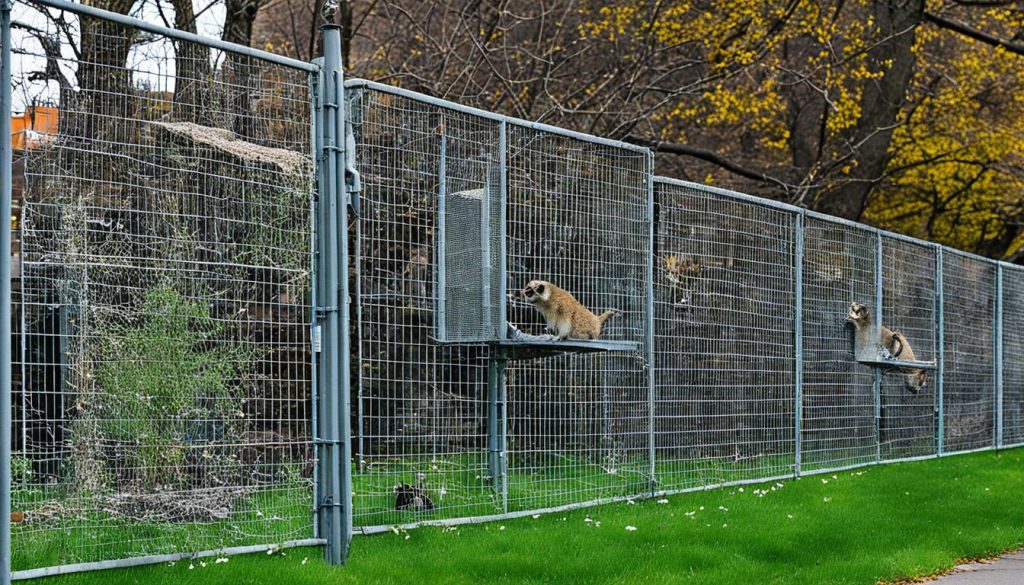Did you know that urban areas are home to a surprising amount of wildlife, even in the midst of bustling cities? In fact, approximately 100 million urban Americans live within a mile of a natural area, creating a unique challenge to manage the coexistence of humans and wildlife.
Urban wildlife management is a crucial undertaking that involves implementing strategies to mitigate conflicts and ensure the harmonious balance between urban areas and the natural habitats of wildlife species. Wildlife control services play a vital role in managing urban wildlife populations and addressing issues such as property damage and public safety, all while focusing on humane wildlife removal methods.
In this article, we will explore the strategies for effective urban wildlife management, wildlife damage prevention, habitat restoration, and population control. By adopting a multifaceted approach, we can create sustainable urban environments that support biodiversity and enhance the well-being of both humans and wildlife.
Key Takeaways:
- Urban areas are home to a significant amount of wildlife, requiring the implementation of effective urban wildlife management strategies.
- Wildlife control services play a crucial role in managing urban wildlife populations and addressing issues such as property damage and public safety.
- Strategies for urban wildlife management include wildlife mitigation, conflict resolution, exclusion techniques, and population control.
- Wildlife damage prevention focuses on minimizing negative impacts on property and infrastructure.
- Habitat restoration efforts aim to create or enhance natural habitats within urban environments, promoting biodiversity.
Strategies for Urban Wildlife Management
When it comes to managing urban wildlife, a proactive approach is essential. By implementing effective strategies, we can minimize conflicts between humans and wildlife while promoting a harmonious coexistence. Wildlife mitigation strategies, urban wildlife conflict resolution, and wildlife exclusion techniques are key components of successful urban wildlife management.
Wildlife Mitigation Strategies
One of the primary goals of urban wildlife management is to reduce conflicts between humans and wildlife. Wildlife mitigation strategies involve the implementation of various measures to prevent wildlife from accessing human-dominated areas. Some examples of wildlife mitigation strategies include:
- Installing fencing and barrier systems to create physical barriers that deter wildlife
- Using deterrents such as noise machines, motion-activated sprinklers, and predator decoys to discourage wildlife from approaching human settlements
- Designing wildlife-friendly landscaping that provides alternative food sources and shelter away from human dwellings
Urban Wildlife Conflict Resolution
Identifying and addressing the specific issues causing conflicts between humans and wildlife is crucial for effective urban wildlife management. Urban wildlife conflict resolution involves understanding the root causes of conflicts and implementing targeted solutions. Some common strategies for conflict resolution include:
- Identifying and addressing food availability issues by implementing proper waste management practices and securing trash cans
- Addressing habitat loss by preserving green spaces and creating wildlife-friendly habitats within urban environments
- Educating the public about wildlife behavior and promoting responsible wildlife interactions
Wildlife Exclusion Techniques
Preventing wildlife from entering or occupying undesirable areas is a key aspect of urban wildlife management. Wildlife exclusion techniques aim to create physical barriers and modify landscapes to discourage wildlife presence in urban areas. Some effective wildlife exclusion techniques include:
- Installing exclusion devices, such as chimney caps and mesh screens, to prevent wildlife from entering buildings
- Creating landscape features that deter wildlife, such as thorny plants or gravel barriers around gardens
- Sealing entry points in buildings and structures to prevent wildlife access
“Implementing wildlife exclusion techniques can significantly reduce conflicts between humans and wildlife while ensuring the safety and well-being of both parties.”
By employing a combination of wildlife mitigation strategies, urban wildlife conflict resolution tactics, and wildlife exclusion techniques, urban areas can effectively manage wildlife populations and maintain a balance between nature and the city. These strategies not only minimize conflicts and property damage but also contribute to the preservation of biodiversity and the well-being of both wildlife and human communities.

Wildlife Damage Prevention and Habitat Restoration
Effective wildlife management in urban areas requires the implementation of measures to prevent wildlife damage and restore habitats. By minimizing the negative impacts of wildlife on property and infrastructure, we can create a harmonious coexistence between humans and wildlife. Additionally, habitat restoration efforts play a crucial role in providing suitable habitats for wildlife and promoting biodiversity.
Wildlife Damage Prevention:
One of the key aspects of urban wildlife management is implementing strategies to prevent wildlife from causing damage to property and infrastructure. This includes securing trash cans to prevent access to food sources and using repellents to deter animals from entering human-dominated areas. Sealing entry points in buildings and structures can also help prevent wildlife from intruding and causing damage.
By taking these preventive measures, we can significantly reduce the occurrence of conflicts between humans and wildlife in urban environments. This not only protects our property but also ensures the safety and well-being of both humans and wildlife.
Habitat Restoration:
Creating or enhancing natural habitats within urban environments is vital for supporting wildlife populations and promoting biodiversity. Habitat restoration efforts focus on preserving existing natural areas, planting native vegetation, and creating green spaces that provide essential resources for wildlife.
Preserving and restoring natural habitats in urban areas not only benefits wildlife but also offers various benefits to humans. These green spaces help improve air and water quality, provide recreational opportunities, and enhance the overall aesthetic value of our cities.
To visualize the importance of habitat restoration in urban environments, consider the following table:

| Habitat Restoration Benefits for Urban Areas | Examples |
|---|---|
| Promotes biodiversity | Planting native trees and shrubs |
| Improves urban aesthetics | Creating urban gardens and green spaces |
| Enhances air and water quality | Establishing green corridors and wetland restoration |
By restoring and creating wildlife habitats in urban environments, we not only provide essential resources for wildlife but also enhance the overall well-being of our cities.
Implementing effective wildlife damage prevention measures and habitat restoration efforts are essential components of urban wildlife management. By minimizing the negative impacts of wildlife on urban areas and providing suitable habitats for wildlife, we can achieve a balance between nature and the city.
Urban Wildlife Population Control
Managing urban wildlife populations is crucial for maintaining ecological balance and minimizing conflicts with humans. By implementing effective population control measures, we can prevent population explosions, reduce competition for resources, and mitigate potential negative impacts on ecosystems and human well-being.
There are several methods of urban wildlife population control that can be employed, depending on the specific circumstances and goals. These methods include:
- Trap-Neuter-Release Programs: Trap-neuter-release (TNR) programs are commonly used for managing feral animal populations. This humane approach involves trapping feral animals, sterilizing them, and then releasing them back into their natural habitats. TNR programs help control the population of feral animals without causing harm, allowing them to live out their lives without contributing to further population growth.
- Contraception: Contraception methods can be implemented for certain wildlife species to regulate their reproduction. This approach aims to reduce the number of offspring produced and control population growth. Contraception methods can include oral vaccines, implants, or injections that interfere with reproductive processes.
- Regulated Hunting or Culling: In some cases, regulated hunting or culling may be necessary to control urban wildlife populations. This approach involves carefully managing hunting or culling activities under strict regulations and guidelines to prevent population overgrowth and maintain ecological balance. It is essential to ensure that hunting or culling practices are carried out responsibly and ethically, with consideration for both the well-being of the wildlife population and public safety.
By implementing these population control measures, urban wildlife populations can be effectively managed, minimizing conflicts between humans and wildlife, and promoting a healthier ecosystem for all.
Conclusion
Urban wildlife management is a complex task that requires a multifaceted approach. By implementing effective strategies for wildlife conflict resolution, damage prevention, habitat restoration, and population control, we can achieve a harmonious coexistence between urban areas and wildlife.
Wildlife control services play a crucial role in implementing these strategies and ensuring the well-being of both human communities and wildlife populations. Their expertise in humane wildlife removal and population control methods helps mitigate conflicts, minimize property damage, and promote public safety.
By prioritizing the balance between nature and the city, we can create sustainable urban environments that support biodiversity and enhance the quality of life for all residents. Through wildlife habitat restoration initiatives, such as the preservation of natural areas and the creation of green spaces, we provide valuable habitats for urban wildlife and contribute to the overall health of ecosystems.
In conclusion, urban wildlife management encompasses various efforts, from wildlife control services to habitat restoration. By combining these approaches, we can effectively control urban wildlife populations, minimize conflicts, and foster a harmonious coexistence between humans and wildlife in our urban environments.
